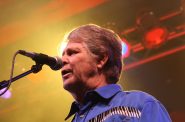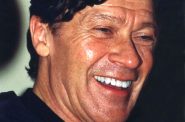The 66 Chapters of Bob Dylan
His new book, The Philosophy of Modern Song, is uneven, idiosyncratic and fascinating.

Bob Dylan at Massey Hall, Toronto, April 18, 1980. Photo by Jean-Luc, (CC BY-SA 2.0), via Wikimedia Commons
Like a mouse to a trap. Bob Dylan releases a tome called The Philosophy of Modern Song and seconds later I’m up till midnight with the iPad illuminating my worshipful face. The title alone is a hook. Who wouldn’t want to devour the musings of the ultimate ultimate in songcraft. Even if he does sneak in something inexplicable like The Eagles “Witchy Woman.” He already lionized them in his almost book-length song, “Murder Most Foul” I never made it to the end of that musical laundry list, I mean… a 17 minute song? Chutzpah on that scale is, shall we say, admirable? That got me worried — would we be reading the Bob that likes to shake things up, like he did with that song and his Frank Sinatra tribute records? I suspect he devises these patience testing exercises from time to time just to see if we’re awake.
The book is longer than I expected, with 66 chapters, each devoted to a song. I skipped a couple I wasn’t familiar with — I want to hear them before I get his take on them. One very noticeable thing is the number of standards, not surprising for a guy who was a teenager when rock’n’roll happened. His love of the Great American Songbook and its finest interpreters is real. He digs deep into Sinatra’s “Strangers In The Night,” and later he riffs on “Something Stupid,” a catchy little novelty Frank sang with his daughter, Nancy. He waxes enthusiastic about “Poor Little Fool,” by Ricky Nelson, considered by some (not me!) to be a pretty boy/lightweight.
I wrote about The Osborne Brothers and their flat-out amazing song “Ruby, Are You Mad?” a while back. It was a pleasant surprise to find it here. It contains a pretty good sample of Dylan’s powers of description. Ruby is “jam packed, full bodied, top heavy and in her prime…” After listing the multitude of genres of Elvis Costello (he covers the first Elvis too), he concludes that the rocker “Pump It Up” gives Costello license to do whatever he wants.
He checks in with the “Big Boss Man” as laid out by the oh-so-cool Jimmy Reed. As for The Boss himself, nary a word on Bruce Springsteen, the most prominent of the many “Next Dylans” he avoids. But really, sixty-six is a small sampling of the mostly American artists he writes about. He could do this again, but who am I kidding, he only repeats himself when it comes to his Sinatra records. Who knows what he’ll do next? Shoot a movie? Write an opera? Maybe he’ll just go fishing, Lord knows he’s earned some down time.
The present day was created by the past and there was an awful lot of music made before the iPad became a lead instrument. He has absorbed so much of it and done so much with that knowledge that it’s entertaining to hear someone who did his fair share of shaping our reality expound on some of the artists and performances that got his attention.
I picked up the physical version while strolling through Barnes and Noble. I was surprised by how big and beautiful it was. I don’t know if Dylan chose the photos that go with it, but they are remarkable and sometimes startling. The first song, “Detroit City” by Bobby Bare, has an image of the artist and his family that can only be described as heart warming. A cloud of smoke obscures the rifle-toting soldier in Edwin Starr‘s, “War,” blinding him to the dangers around him. Really, there should be a travelling exhibit of these images.
I didn’t like the slow-moving, repetitious parts, but… dipping back in I’m a little more forgiving. I think it’s the kind of book that will benefit from a non-linear approach. That is, after all, the way of its author. If that should fail, I’ve been told the audio book is better. With his deep sepulchral voice sounding at least as old as anything in the book, how could it not be? I think I might pop the earbuds in and find out. After all, it’s not what you say, but how you say it — Bob Dylan knows that as well as anyone.
If you think stories like this are important, become a member of Urban Milwaukee and help support real, independent journalism. Plus you get some cool added benefits.
Sieger on Songs
-
Remembering Brian and Sly
 Jun 26th, 2025 by John Sieger
Jun 26th, 2025 by John Sieger
-
The Legacy of Robbie Robertson
 Sep 28th, 2023 by John Sieger
Sep 28th, 2023 by John Sieger
-
Bill Nighy Sings ‘The Rowan Tree’
 Apr 12th, 2023 by John Sieger
Apr 12th, 2023 by John Sieger




















“…he likes his music handmade and a little wrinkly.”
A phrase that creates a great visual. It can include both the composer and the listener.
Great review. I’m intrigued.